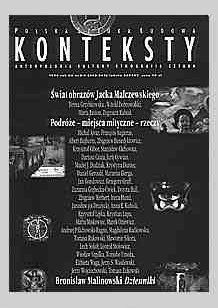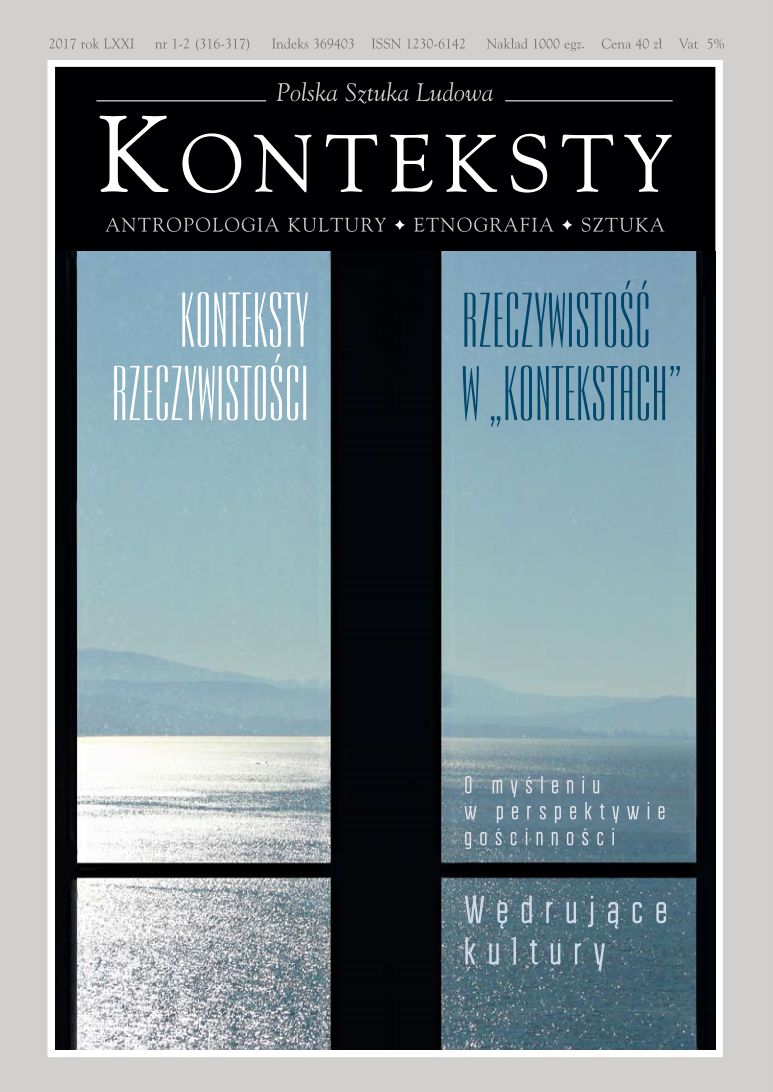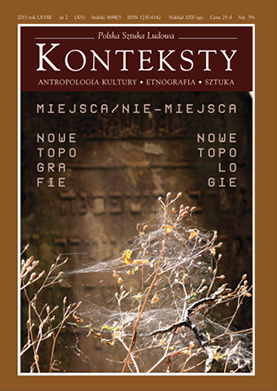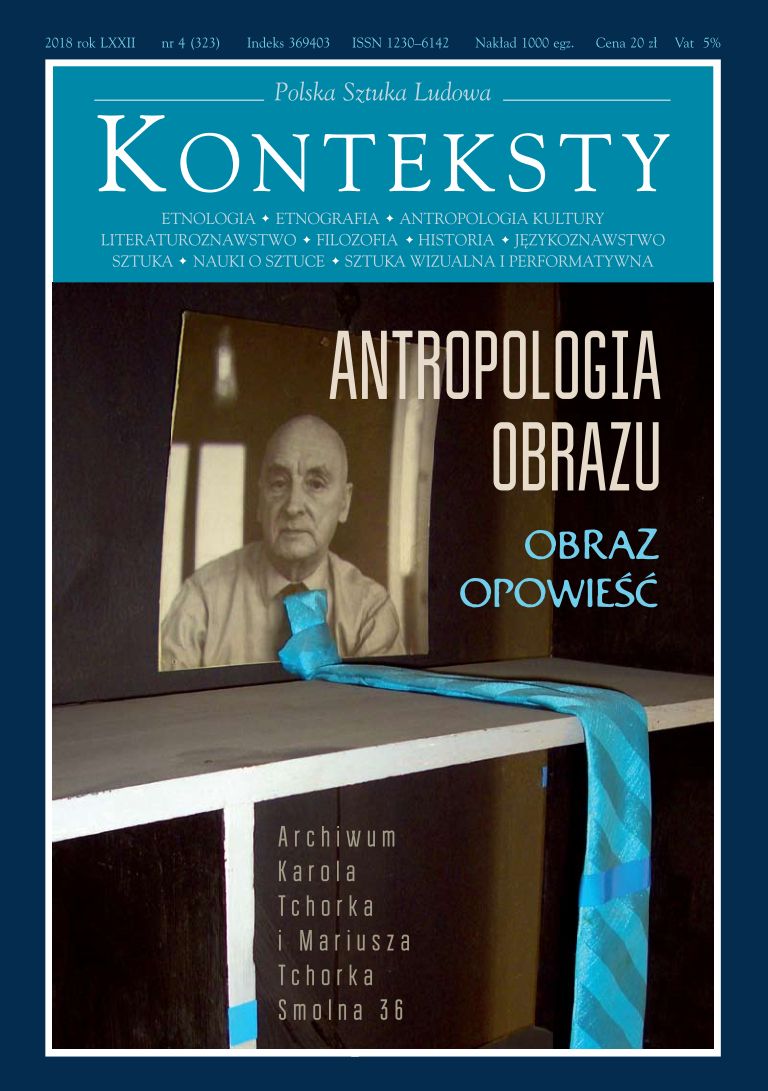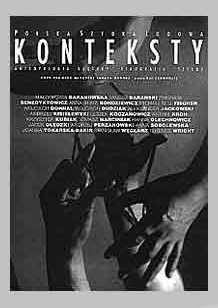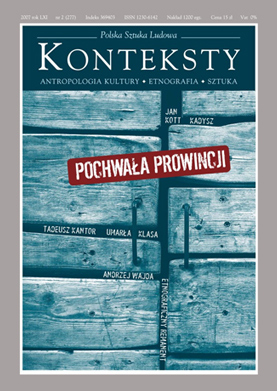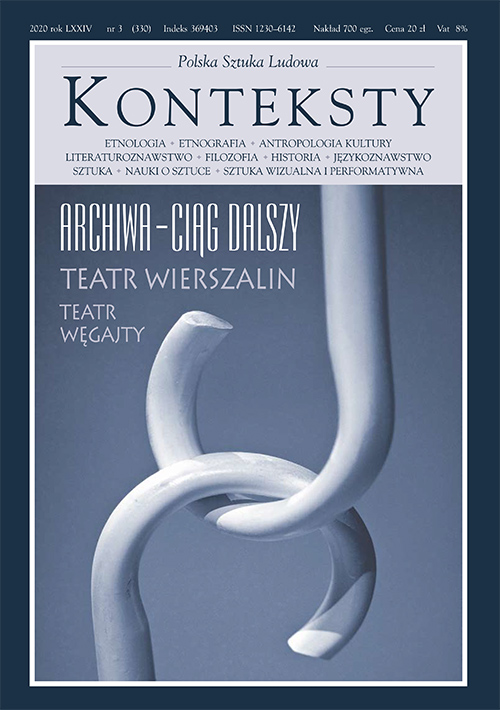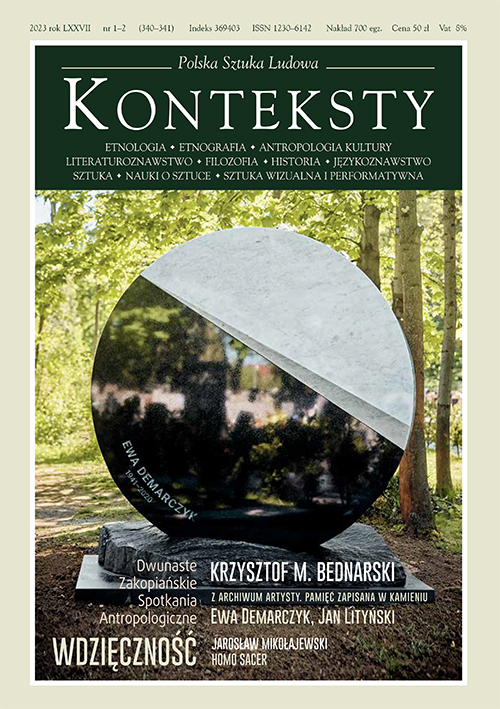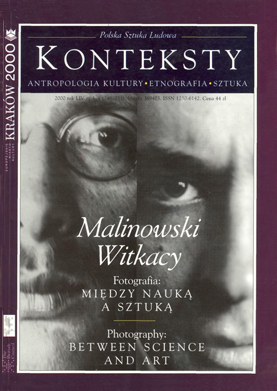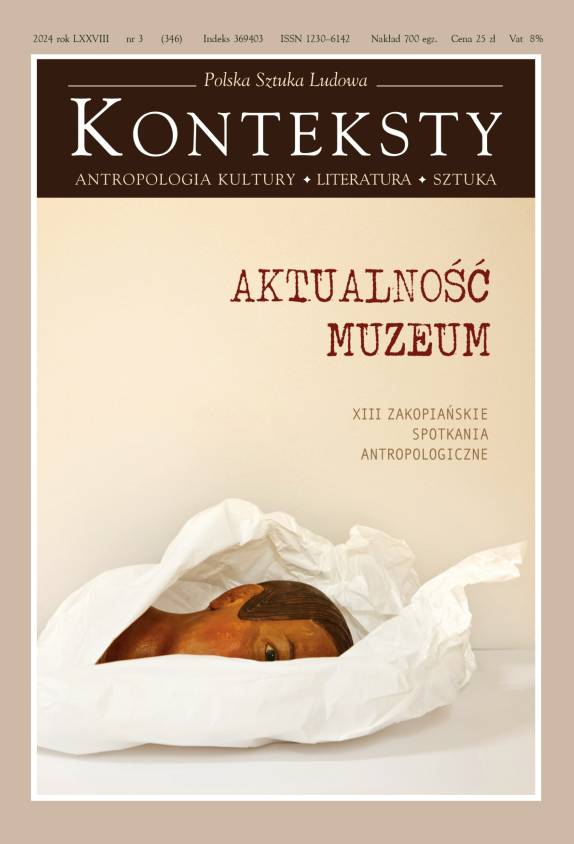Issue 2014/3-4 (306-307) - W.G. Sebald. Anthropology, Literature, Photography

| Zbigniew Benedyktowicz, Dariusz Czaja, Tomasz Szerszeń | W.G. Sebald – Anthropology, Literature, Photography | 4 |
| N. N. | W.G. Sebald. Biographical Note | 11 |
| Tomasz Szerszeń, Dariusz Czaja, Zbigniew Benedyktowicz | Senavogel. An Interview with Małgorzata Łukasiewicz  | 12 |
A record of a conversation about the oeuvre of W. G. Sebald held with Małgorzata Łukasiewicz, an expert on Sebald’s works and their translator into Polish. | ||
| Jan Peter Tripp, W.G. Sebald | Unerzält Unrecounted  | 23 |
Seven poems and portraits from a book written jointly by W. G. Sebald and Jan Peter Tripp: Unerzählt (Carl Hanser Verlag, München 2003). | ||
| Narratives | ||
| Eleanor Wachtel | Ghost Hunter. An interview with W.G. Sebald  | 32 |
An interview with W. G. Sebald from The Emergence of Memory: Conversations with W. G. Sebald (ed. Lynn Sharon Schwartz, New York 2010). | ||
| Carsten Strathausen | Going Nowhere: Sebald’s Rhizomatic Travels  | 40 |
This text comes from: Searching for Sebald: Photography After W. G. Sebald (ed. Lise Patt, Christel Dillbohner, Institute of Cultural Inquiry, Los Angeles 2007). | ||
| Amanda Hopkinson | A History of Memory or a Memory of History?  | 53 |
The text of an essay about W. G. Sebald (broadcast on 9 December 2011; BBC3). | ||
| George M. Hyde | The Rings of Saturn  | 57 |
Max’s enemy everywhere is the totalising overview. His art is designed to correct or subvert this kind of cognitive aberration which can be so misleading and dangerous. His narratives of East Anglia offer melancholy fragments with a wide historical and cultural range of possibilities. I begin this essay with an example of my own from a masterpiece of German culture in order to frame my account suggestively in relation to Max’s own lifelong struggle with the land that bore him and which he felt impelled to reject, while acknowledging its colossal contribution to human knowledge and experience. Like Walter Benjamin Max values most the kind of quincunx-links that arise intuitively and spontaneously (as in the work of Sir Thomas Browne, the great Norwich writer and thinker) between domains of experience that cannot be connected by a totalising overview. The vivid images that his works embody are similarly at odds with the ever-sharper digitised perceptions that we now experience on a daily basis but which lack any kind of depth of field and so have no experienced life in them. My only quarrel with Max’s way of working is that in his pursuit of his “illuminations” he is inclined to set aside what may already have been thought and said by other writers. The effect of this is a foreshortening that may be a kind of distortion. A historian once said to me that despite his fascination with history Max was not a historian. For me this does not constitute a weakness, but I think it is a fact. | ||
| George M. Hyde | Emigrants by Sebald – A Tribute to Nabokov  | 62 |
The Emigrants is a book more closely integrated as a narrative than The Rings of Saturn but still not a novel in any obvious way. I have called it “a novel in a kaleidoscope”, since it keeps getting shaken up by the presiding “fokusnik” (Russian for “conjurer”, a word Nabokov loved) and its focal point shifts accordingly, on both sides of the grave. An abyss keeps opening exactly where the narrator is standing, just as it does in many of Nabokov’s fictions. A shameless appropriation of photographs, some private as if really from the family album, some from the public domain, supports the narratives that seem to be emerging to clarify family histories but actually cast a further veil of darkness and death. Nabokov asks what the “real life” of his character (Sebastian Knight) is, and the answer is the page in front of your nose. Kantor wonders at the disappearance of his father but sees no point in setting out in his pursuit. Photographs simply confirm the deadly encroachment of time on anything we may think significant. We have all emigrated from a world we do not remember, as Nabokov reminds us in Speak, Memory. We are now on our way to another world from which no-one has ever returned. Our fate is a lonely one, like that of the principal protagonists of The Emigrants. Death shadows it, as it shadows Hersch Seweryn, or Henry Selwyn, in his Gothic house and garden not altogether unlike Max’s. The reported accident that took the life of Henry’s alpine guide friend emphasises what so many holocaust survivors felt: that they had no right to be living at all when so many had been murdered or had their lives utterly ruined. Paul Bereyter is an extraordinary embodiment of the falsifications of Nazi history and racial theory. Max gives him enough sympathetic attention to make us feel the tragic loss of a man of goodwill and culture. His suicidal depression might have been averted. But how? The Ambros Adelwarth story is perhaps over-complex but it is a bold attempt to grasp the nettle of American Jews and their astonishing creativity. To follow them consistently through their zig-zag progression over the “dream-bright” map of America is a challenge. To cap it, Max brings himself “home” to Norfolk, whence he travels to revisit the now successful artist friend from his Manchester days, Ferber. | ||
| George M. Hyde | Sebald Austerlitz or Auschwitz | 67 |
| Małgorzata Sady | Is there anything similar? Fragments of a conversation with George M. Hyde | 71 |
| Clive Scott, George M. Hyde, Małgorzata Sady | Undefined Literature. Life in Uncertainty. A Conversation on Sebald in Norwich | 73 |
| Małgorzata Łukasiewicz | We Merely Philosophise  | 76 |
A depiction of discreet links between the writings of W. G. Sebald and the philosophy of Ludwig Wittgenstein, starting with traces of the thinker’s biography subtly intertwined in the text of The Emigrants, and a scenario written by Sebald for a film about Wittgenstein (Leben Ws.), to more general evidence of the affiliation of both protagonists representing similar sensitivity and intellectual predilections. | ||
| Jakub Momro | Prosthethic Memory  | 81 |
This text analyses works by W. G. Sebald from the viewpoint of the paradigm of “musical historiosophy”. Contrary to heretofore interpretations, the author created a constellation of meanings associated with the dialectic of sound and subjecting to it the dimensions of spatial and visual presence. From this transition he derived the conception of the catastrophe both as an apocalypse of the language and a permanent disintegration of the world. Due to this shift of the analytical dominant the author constructed the conceit of “prosthetic memory”, i.e. one that cannot manage without a certain mnemotechnical surplus rendering possible a redistribution of traces of the past and history. | ||
| Agata Sierbińska | W.G. Sebald. Ruined Memory  | 93 |
Works by W. G. Sebald, brimming with citations and references and examining the relation between fact and fiction, have been the topic of multiple interpretations. The popularity of his oeuvre among researchers is connected with the ease of its translation into the contemporary academic discourse. One should ask, therefore, whether today novels and essays by this German man of letters could comprise a topical proposal for the critics, considering that they had been already studied in so many ways by academics. The presented text attempts to deliberate on this problem via an analysis of the relation between Sebald’s works and the reflections of Walter Benjamin or, to put it differently, by presenting the manner in which W. G. Sebald revived and tested ideas conceived by the author of On the Concept of History. | ||
| Dariusz Czaja | Herrings, Moths, Silkworms. Sebaldian Zoology | 101 |
| Images | ||
| Jeremy Millar | A Firework for W. G. Sebald 2005-2006  | 111 |
A commemoration and remembrance firework in honour of the extraordinary life and oeuvre of W. G. Sebald was ignited by the artist Jeremy Millar alongside the A146 near Framingham Pigot, on the spot where Sebald died in a car accident on 14 December 2001. | ||
| Tacita Dean | W.G. Sebald  | 112 |
A visual essay by a British artist fascinated with Sebald, published in “October” no. 106 (Fall 2003). | ||
| Paweł Mościcki | Saved in Montage. Image, Empathy and Counter-history in Austerlitz by W.G. Sebald  | 123 |
This attempted analysis focuses on the motif of empathy in the oeuvre of W. G. Sebald from the historical perspective and within the context of relations between the text and the image in Austerlitz. The argument is based on a fragment in which the titular protagonist, seeking an image of his mother, comes across a Nazi propaganda film made in the Theresienstadt ghetto at the end of the war. Apparently, the path towards an empathetic encounter with one’s past and the traumatic history of Europe leads across montage, in which observed images become rendered as problems and salvaged. | ||
| Mattias Frey | Theorizing Cinema in Sebald and Sebald with Cinema  | 135 |
The text originates from: Searching for Sebald: Photography After W. G. Sebald (ed. Lise Patt, Christel Dillbohner, Institute of Cultural Inquiry, Los Angeles 2007). | ||
| Katarzyna Bojarska | Sebald / Weliczker. An Attempted Take at Historical Photography  | 145 |
The author compared two seemingly incommensurate works: a diary by Leon Weliczker – The Death Brigade, and three examples of prose by W. G. Sebald – The Emigrants, Austerlitz and The Rings of Saturn. In this way, she pursued reflections about the place of photography in narrations concerning the traumatic past and proposed a hypothesis on the possible role played by historical photography vis-à-vis the modern or post-modern interpretation of history. K. Bojarska is interested not in that, which can be seen in the analysed photographs (or rather the uses of photography) but with that to which they refer, the role, which they play in the process of imagining and associating, as well as in the creation of history, and not its recreation. | ||
| Piotr Krajewski | The Rings of Saturn. On the Transit of Saturnian Motifs in Contemporary Art  | 156 |
A presentation of the exhibition Pierścienie Saturna (The Rings of Saturn) held in the former Ballestrem Palace in Wrocław as part of the 15. Media Art Biennale 2013: Pioneering Values. May – June 2013. | ||
| Antoni Ziemba | Sebald and The Anatomy Lesson of Dr. Nicolaes Tulp  | 159 |
A footnote by an historian of art and expert on Rembrandt and seventeenth-century Dutch painting to a fragment of The Rings of Saturn, in which Sebald wrote about The Anatomy Lesson of Dr. Nicolaes Tulp. | ||
| Antoni Ziemba | Images of Life – and Death. Likenesses of the Dead  | 161 |
The article comes from the book: Iluzja a realizm. Gra z widzem w sztuce holenderskiej 1580-1660 (2005). By resorting to his experiences as a researcher, lecturer, and museum expert, the author presented a lavishly illustrated and thoroughly humanistic dissertation transcending the hermetic scientific discourse and accessible to all readers interested not solely in Dutch art of the Golden Age, but also in the history of European art and culture. | ||
| Journeys | ||
| W.G. Sebald | Campo Santo  | 173 |
A chapter about Corsican cemeteries from Campo Santo. | ||
| Ria Van Hengel, Eduard Van Hengel | The Rings of Saturn. Sebald’s Pilgrimage | 179 |
| Robert Macfarlane | Afterglow, or Sebald The Walker  | 193 |
This text comes from the catalogue: Waterlog. Journeys Around An Exhibition (ed. Steven Bode, Jeremy Millar, Nina Ernst, Film and Video Umbrella, London 2007). | ||
| Tomasz Szerszeń | Gare Austerlitz  | 196 |
Sebaldian topography, similarly to his prose, misleads us by creating tangled, complex images – veritable “lines of motion, lines of life”, elements of a phantom psycho-geography mutually superimposed as in a palimpsest. This psycho-geographical context takes us to Paris, the scene of the closing and extremely important fragments of Austerlitz. The text is inseparably connected with a journey on foot (which, as is always the case with Sebald, features a rhizomatic, convoluted character) near the oldest Parisian railway station and within the surrounding 13th arrondissement, and involves walking in circles, a series of seemingly chaotic movements and transferences, and a narration whose meaning comes into being somewhere between the Seine, the New Library, the National Museum of Natural History, and the Pitié-Salpêtrière Hospital… The text is a sui generis photonovel, with the author following Austerlitz all over Paris. | ||
| Brian Dillon | Airlocked  | 203 |
The text comes from the catalogue: Waterlog. Journeys Around An Exhibition (ed. Steven Bode, Jeremy Millar, Nina Ernst, Film and Video Umbrella, London 2007). | ||
| Emilia Olechnowicz | “Last Glimpse of the Land Now Being Lost for Ever”  | 207 |
A presentation of an exhibition and accompanying catalogue: Waterlog. Journeys Around An Exhibition (ed. Steven Bode, Jeremy Millar, Nina Ernst, Film and Video Umbrella, London 2007). | ||
| Thomas Browne | Praise of Fiction  | 211 |
A fragment of Religio Medici, a seventeenth-century treatise by Sir Thomas Browne (part 2, chapter 11-12). | ||
| Contexts | ||
| Roland Barthes | Le message photographique  | 212 |
A translation of a classical text: Le message photographique, originally published in “Communications” in 1961. | ||
| Tomasz Swoboda | Camera obscura  | 218 |
This essay endeavours to decipher the closing years of Roland Barthes as a photograph. Contrary to the title of his last book, Barthes wrote and constructed more of an existential camera obscura whose mechanism served the task of mourning, i.e. La Chambre claire, as well as disclosed the fundamental figures devised in his imagination, namely, darkness and enclosure. The biography of Barthes’ last years proves to be a counterpart of an initiation–like transition towards darkness, the digging of one’s grave, and a reversed version of illumination. | ||
| Paweł Dybel | Image. Copy. Original. The Ontology of the Image in Gadamer’s Hermeneutics  | 227 |
The article extracts premises of the ontology of the image according to H. G. Gadamer. In doing so, it follows the complex relations maintained in this conception by the image (das Bild), the copy (das Abbild) and the original (das Urbild). The article attempts to demonstrate that the titular ontology radically rejects the conception of emulation in art. According to the author of Truth and Method, das Abbild is not a copy of a perceived image but within the latter that, which is seen appears as self-reflection; hence the illusion of the “reality” of the image in the mirror. Secondly, the original does not possess the character of a model, which exists independently of the image; one can, however, speak about its existence only in the perspective of an image in which a sui-generis growth of being takes place. According to this interpretation, the message of images in art does not involve rendering reality as faithfully as possible but revealing aspects that remain invisible on a daily basis. Art does not impoverish reality by copying or selecting; by drawing forth its essence it confronts us with the, as a rule, concealed truth of being. | ||
| Dariusz Czaja | Microhistories. Maps without a Legend  | 236 |
A text accompanying Invisible Maps, a book by the photographer Andrzej Kramarz. | ||
| Hubert Francuz | The Glances of My Sisters  | 241 |
In 2011 a collection of more than 2 500 glass negatives from the pre-1939 period was discovered in a townhouse attic in Lublin. Nothing is known about the author or the persons in the photographs. How are we to write and speak about photographs if they offer nothing more than visibility? The establishment and retention of a close relation with an image, in particular a photograph, is a choice made by the spectators. The wish to see someone in the photograph in the way one would want to see him appears to be a facile trick of the imagination. At the same time, it is also an act of assuming responsibility for those whom one sees as well as the unpredictable course of their possible and impossible biographies. In view of the acute absence of source knowledge about the Lublin collection of negatives this article attempts to examine them via publications by W. G. Sebald and Thomas Bernhard. | ||
| Paweł Próchniak | The Human Note Remarks on the Margin of Asymetria  | 249 |
The author conducted a thorough analysis and interpretation of poems from Asymetria, a volume by Adam Zagajewski (2014). In order to better extract and enhance the prime motifs and motives of Zagajewski’s poetry their meanings were depicted against the backdrop of statements made by W. G. Sebald about the potential and tasks of literature. Zagajewski has a high regard for Sebald’s prose but vehemently protested against the pessimistic vision of the world contained in his books. While accentuating the significant differences in both writers’ perception of reality, the article ultimately draws attention to a prominent issue shared by them: a dream of literature conceived as restitution. | ||
| Dariusz Czaja | Melancholies. A Musical Triptych  | 254 |
Three essays from a book about Baroque music (Kwintesencje. Pasaże barokowe) deal with the “dark semantics” of compositions by John Rowland, Carl Gould, and Matthias Beckmann. The author portrayed Baroque music as a “speech of sounds” and followed its expression potential, in particular as regards the capacity to convey extreme states and emotions (sadness, despair, melancholy and death). | ||
| Tomasz Dominik | The Almagest. Music, Scores, Calendars, Maps, Compass Roses – Lithographic Inspirations | 265 |
| Oleg Ljubkiwskyj | Mythical City | 273 |
| Jurij Smirnow | On the Ruins of an Empire | 277 |
| Zbigniew Benedyktowicz | Forgotten Words: Krachla and sztolwerek – serwus, serwus..., Kristi-Kotka Szamaliner! | 281 |
| Zbigniew Benedyktowicz | Krachla and sztolwerek – aneks | 291 |
| Zbigniew Benedyktowicz | Ninety One Words. About Forgotten Words – more | 294 |
| Other Images | ||
| Marta Leśniakowska | Identification Order. The Indexicality of the Józef Robakowski Collection / Archive  | 297 |
This text deals with the “archival turn“ and discusses one of the most important Polish private collections of avantgarde art formed since the 1950s by the leading conceptual artist Józef Robakowski. The author’s point of departure is the assumption that the purpose of collecting is the creation of a canon of cultural values, and thus that collecting is the outcome of selecting and systematising facts/objects according to a priori established rules; for this reason it only ostensibly possesses all the features of neutrality. Actually, no collection is neutral since it personifies power inscribed into accumulating, collecting, and gathering as well as encyclopaedic order and rules of the language (Alan Sekula). Private art collections are the effect and image of individual passions, predilections, sometimes manias and obsessions, and build closed and stable testimonies of cultural identity. Archives-collections established by artists are a special case since they are part of artistic strategy, are enrooted in art, and perform work associated with creativity. This fact discloses a certain performative quality of the collection/archive linked with the generation of a private iconosphere, a Derridean “domesticated” archive that constitutes the discourse of the artist-collector with, and about art, also within the domain of “pure” art, which is already only one of the possibilities of artistic strategy. The discussed exhibition was the product of the “domesticated” art collection amassed by Robakowski, and in this manner it builds inter-textual space, ambiguous and connected with its re-[de]-contextualisation. The Robakowski private collection/archive is a conceptual game played with cultural paradigms, originating from the conceptual art of the 1960s and its anti-authoritarian stands conceived as the “great refusal”. The manner of its distribution is part of the conceptual order as a form of artistic organisation and production. At this stage essential questions are yielded by the comprehension of conceptualism by artists living in communist Eastern Europe, where the purpose of conceptualism was not “refusal“ but the involvement of art as a critique of the regime in which it was embedded. This is why the “museum-archival” project proposed by Józef Robakowski, and entailing the collection of objets d’art and documents, focused on memory and history, together with faith in the reanimation ability to “revive” the source and “recreate” the inaccessible past. | ||
| Marta Leśniakowska | Karska & Went & Duszeńko. On the Dual Nature of the Monument and Exhibiting It  | 307 |
With the concepts of mise-en-scène, event (Mieke Bal), archival turn, and preposterousness as its points of departure the text embarks upon an extensive interpretation of the newest project by Alicja Karska and Aleksandra Went, who working together often undertake the problem of recovering for culture that which is forgotten, omitted, and excluded. The author took into consideration the fact that the performative dimension of the art studio is included into the museological order together with its ritual of forgetting and recalling: the studio is a repository of objects awaiting their disclosure and introduction into social space, ergo, to be given a new life. The Karska & Went project: Franciszek Duszeńko – Monuments is about an unknown sequence in the oeuvre of Franciszek Duszeńko (1925-2008). The authors of the exhibition extracted from his studio-refuge a dozen small abstract sculpture forms and by treating them as a sui generis archaeological finding transferred them into a specially constructed architectural space, i.e. models imitating museum or gallery interiors of the white cube type. In this way, they staged a mise-en-scène: a model of a museum/exposition situation in which a fragment of the artist’s studio conceived as non-space, i.e. that which is found on the peripheries of the existing orders, has been subjected to institutionalisation and engaged in a construction of a fictional museum/gallery. The essence of the applied artistic strategy is preposterousness: (neo)avantgarde sculptures, traces, documents, and relics pertaining to a certain moment in the artist’s oeuvre are seen from a present-day perspective and subsequently cited. In this fashion they become a contemporary product, causal for making another work of art. Applied/cited in present-day artistic praxis they attempt to solve the way in which, and reason why works of art from the past are always perceived as re-vision mediated by the horizon of contemporaneity. The quotation strategy employed in this assemblage is associated with interpretation and thus with conceptualisation. In other words, it is preposterous. This is also the objective of the Karska & Went project: the creation of a trans-historical artistic (cultural) situation that rejects the radicalism of divisions and severances in the history of art. The diverse strategies applied by Karska & Went: anachronism, preposterousness, mise-en-scène, mise-en-abyme, montage, collage, and quotation served the establishment of a new relation between the history of art and its present-day experiencing. | ||
| Łukasz Kossowski | Scandals at the Turn of Centuries  | 313 |
The objective of this text is to demonstrate fundamental differences in comprehending a scandal at the end of the nineteenth century (E. Munch, Madonna) and the scandal strategy in contemporary art (M. Cattelan, La Nona Ora / The Ninth Hour). In the first case an unintended scandal was the outcome of a philosophical stance adopted by artists questioning Cartesian tradition as well as of the use of Expressionist means, considered shocking at the time. In the second instance, the deliberate creation of the scandal strategy assumed the relegation from the discourse about the artwork of all aesthetic and formal deliberations as well as stirring a barren publicistic dispute, which only creates the appearances of a philosophical clash. A context indispensable for the success of such a devised provocation is the ritual chaos prevailing in the media and a milieu of art critics dominated by “political correctness”. | ||
| Sebastian Borowicz | Imagine perversa and Narration Identity. Several Remarks on “Unsuitable Images” from the Perspective of Past Cultures  | 320 |
Anus ebria is an image founded on anti-ideas, clichés that break or openly violate the cultural taboo, such as women’s drunkenness, sexual freedom, or emancipation from norms moulded by tradition. In its capacity as a jeering and comic “divulger” of norms and principles it becomes one of the more characteristic signs of the “eschatology of inebriation”. This is the case not so much of an “old drunk” as of an “old rebel”. In its visual and logistic dimension it assumes the form of a lascivious and old drunken woman, whose vulgar behaviour is a distinct reversal of the natural state of being desired by society. | ||
| Beata Di Biasio | Statutes-installations by Igor Mitoraj: Between Antiquity, the Renaissance and Postmodernism  | 335 |
Sculptures by Igor Mitoraj comprise a sui generis bridge spanning over more than 25 centuries of European art. The pillars of this bridge are composed of a great triad of figures: Doryphoros by Polyclitus, designed as a demonstration of the artist’s Canon, David by Michelangelo, and Icarus by Mitoraj. In aesthetics the pillars of this edifice are philosophers representing three different epochs of reflection on art: Plato, Plotinus, Ficino and contemporary postmodernists. Three statues and three different conceptions of beauty captured in stone symbolise three epochs in the history of art: antiquity, the Renaissance, and contemporary art from the turn of the twentieth century. | ||
| Jolanta Sztachelska | Ateny nad Izarą. Malarstwo monachijskie. A Review  | 343 |
The book: Ateny nad Izarą. Malarstwo monachijskie recalls the role played by the Munich centre in the history of Polish culture at the turn of the nineteenth century. In doing so, J. Sztachelska stressed, above all, those features of the Royal Academy of Fine Arts, which in view of the absence of Polish counterparts guaranteed numerous Polish artists unhampered and comprehensive development, contact with European art and culture, and even – by way of a special paradox - rendered more profound their interest in specific Polish motifs: history and Nature, thus inclining them towards the pursuit of national art. It would also be difficult to exaggerate the significance of Munich in paving the path for Polish art towards general awareness due to the commercial successes of such artists as Maksymilian and Aleksander Gierymski, Alfred Wierusz-Kowalski, Władysław Czachórski, Józef Brandt and many others. The art market flourishing in Bavaria became for many the onset of intellectual acclaim. The book edited by Eliza Ptaszyńska brings the reader closer to the schooling of Polish artists in Munich, depicts their daily life, contributes to familiarity with the question of female artists, leads to painters’ studios, discusses the market mechanisms of their success and, finally, interprets their artistic accomplishments and progress. In doing so, the author portrays the Munich milieu, producing an image both complete and free of all prejudices. | ||
| Irena Kossowska | Latvian Latvia? Latvian Art in the Second Republic  | 351 |
The article discusses the critical reception of an exhibition of contemporary Latvian art opened on 28 March 1936 in the showrooms of the Society for the Encouragement of Fine Arts in Warsaw (Zachęta). The Latvian show was part of a sequence of official art exhibitions of national states, which during the interwar decades functioned faultlessly and linked the central and peripheral centres of the Old Continent into a thick network of exchange. Its reception by Polish authors of reviews exemplified a striving characteristic for the cultural discourse of the 1930s, aimed at capturing in the fine arts certain symptoms of national identity. The presented text is based on a confrontation of several viewpoints concerning the exposition: the perception of Warsaw commentators unfamiliar with the details of transformations transpiring at the time on the Latvian art scene, reflections by Latvian theoreticians of art during the 1930s, and narrations by contemporary historians of Latvian art. An analysis of the exhibition scenario (determined by the cultural policy of the then recently politically constituted Baltic country) and the semantic and morphological qualities of the works on show at the Zachęta defines “national art” and “national style”, and verifies the possibilities of translating critical-theatrical rhetoric into purely art values. | ||
| Jan Gondowicz | Monsieur Sans-Gêne  | 361 |
The forgotten man of letters and acclaimed graphic artist Feliks Jabłczyński (1865-1928) led an experimental life and became part of the Warsaw legend. He discreetly contested bourgeois manners and morals as well as the rules of prose and the pursuit of the arts. From the perspective of a century he appears to have been a precursor of Polish artistic miserabilism, a fully conscious creator of the aesthetics of recycling in the spirit of Leśmian (whom he befriended), Witkacy, Schulz, Jonasz Stern, Kantor, Białoszewski and Hasior. | ||
| Jan Gondowicz | The Impossible and the Improbable  | 365 |
Father Brown, the detective from the series of short stories by G.K. Chesterton, appears to be a combination of impossible and contradictory features. The author designed him as paradoxical protagonist so as to present the incompatibility of psychological truths and moral laws. Actually, Father Brown expresses the indelible paradoxical nature of the plots of the crime story, which as literary genre does not assume any sort of an attitude to crime as such. | ||
| Paweł Polit | Jeremy Millar, M/W  | 369 |
A text by the curator of M/W, an exhibition of works by Jeremy Millar held at the Łódź Art Museum in 2014. | ||
| Lisa Le Feuvre | Given – a Conversation with Jeremy Millar  | 371 |
A record of a conversation, with Given, the Jeremy Millar exhibition at the National Maritime Museum in Greenwich, as the point of departure. | ||
| Wojciech Sztaba | “I Miss the Tropics”  | 377 |
The text follows the traces of the journey to the tropics made by Bronisław Malinowski and Stanisław Ignacy Witkiewicz. | ||










